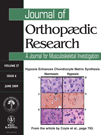Chondrocyte death in mechanically injured articular cartilage—the influence of extracellular calcium
Abstract
Calcium is thought to be an important regulator of chondrocyte death associated with articular cartilage injury. Our objective was to determine the influence of extracellular calcium on chondrocyte death following mechanical injury. Using a surgically relevant model of sharp mechanical injury (with a scalpel) and confocal laser scanning microscopy (CLSM), in situ chondrocyte death was quantified within the full thickness of articular cartilage as a function of medium calcium concentration and time (2.5 h and 7 days). Exposure of articular cartilage to calcium-free media (∼0 mM) significantly reduced superficial zone chondrocyte death after mechanical injury compared with exposure to calcium-rich media (2–20 mM, ANOVA at 2.5 h, p = 0.002). In calcium-rich media, although the extent of chondrocyte death increased with increasing medium calcium concentration, cell death remained localized to the superficial zone of articular cartilage over 7 days (ANOVA, p < 0.05). However, in calcium-free media, there was an increase in chondrocyte death within deeper zones of articular cartilage over 7 days. The early (within hours) chondroprotective effect in calcium-free media suggests that the use of joint irrigation solutions without added calcium may decrease chondrocyte death from mechanical injury during articular surgery. The delayed (within days) increase in chondrocyte death in calcium-free media supports the use of calcium supplementation in media used during cartilage culture for tissue engineering or transplantation. © 2008 Orthopaedic Research Society. Published by Wiley Periodicals, Inc. J Orthop Res 27: 778–784, 2009




